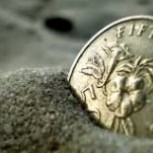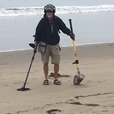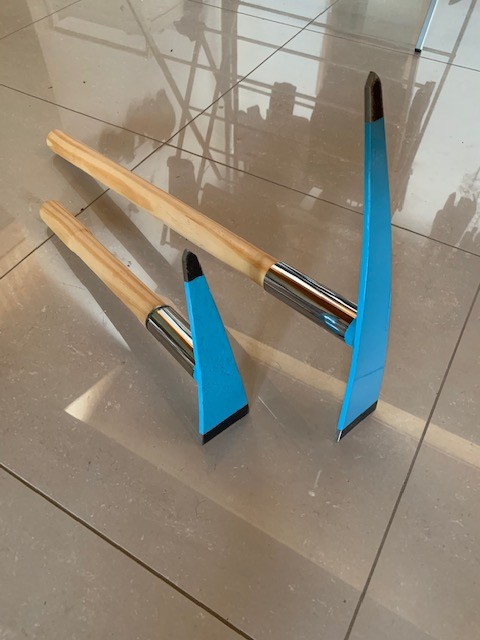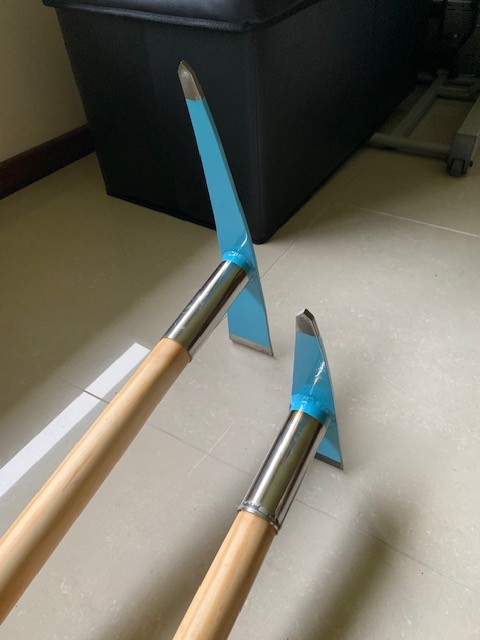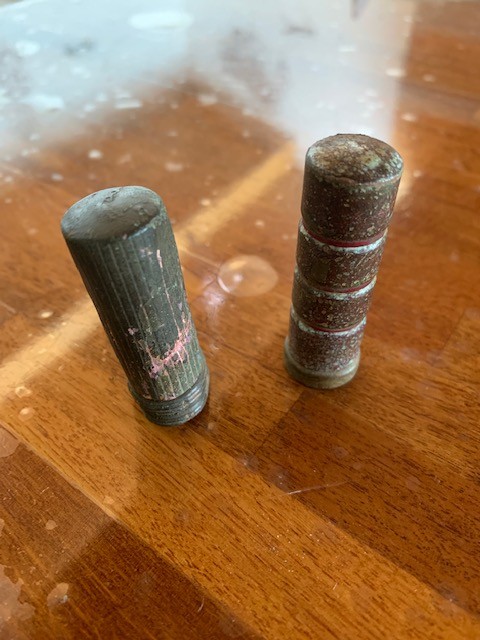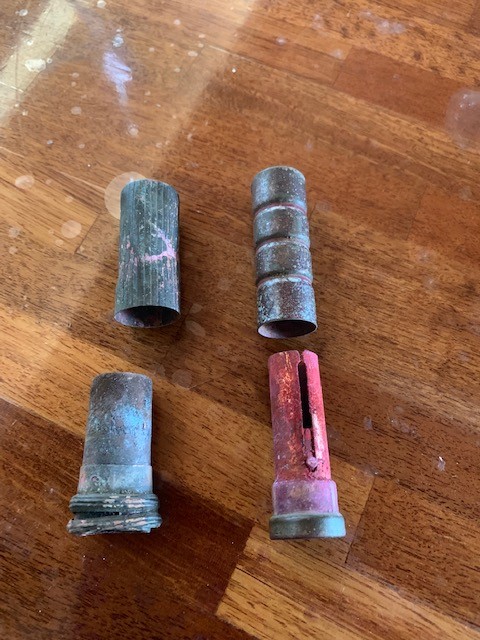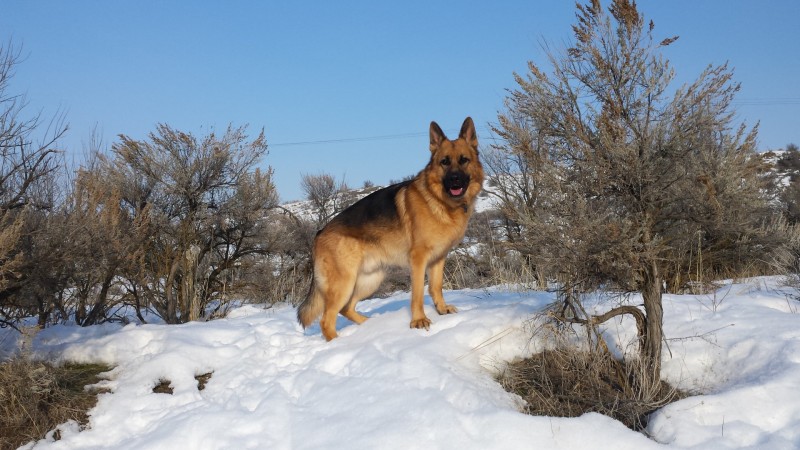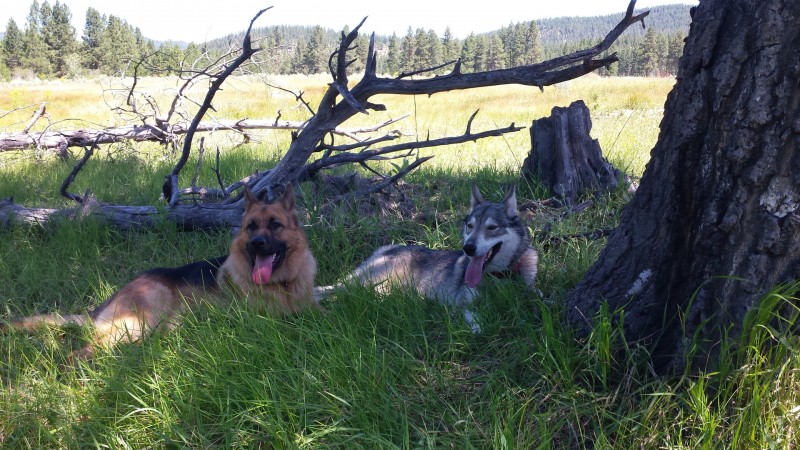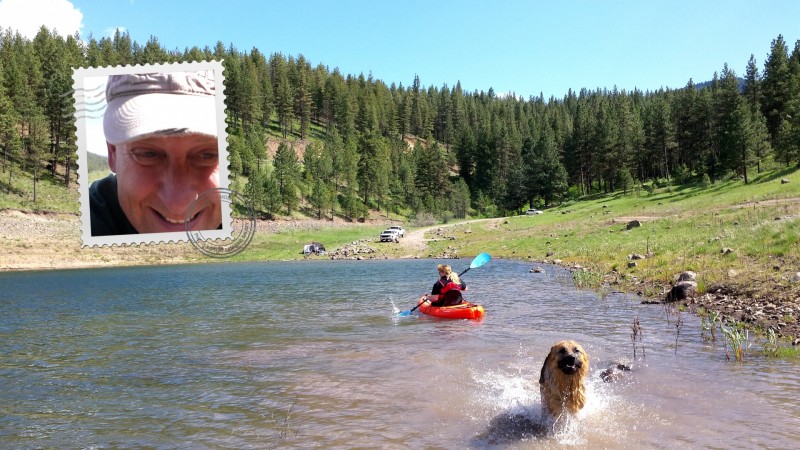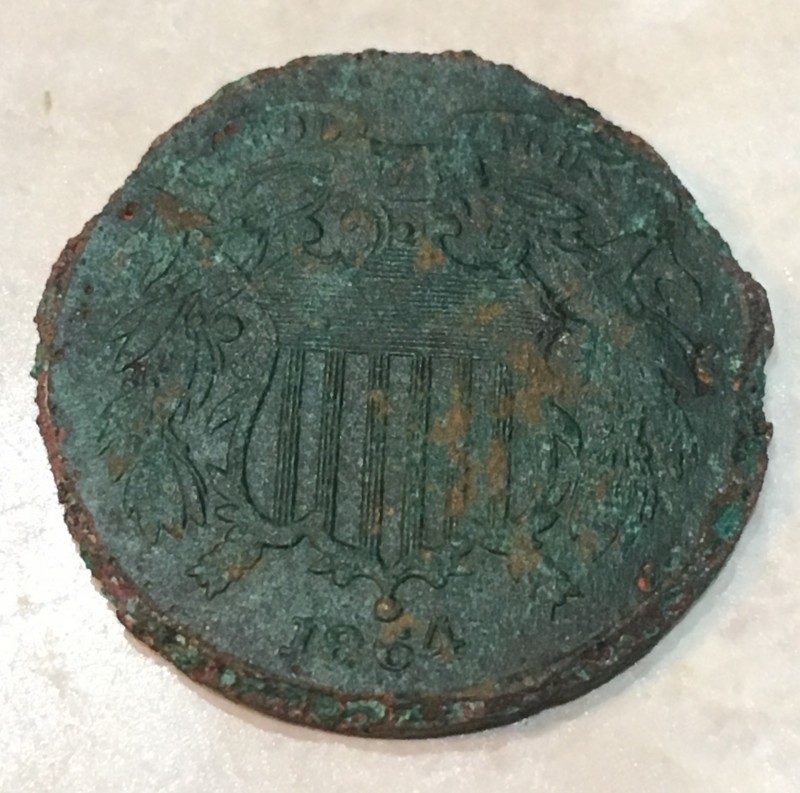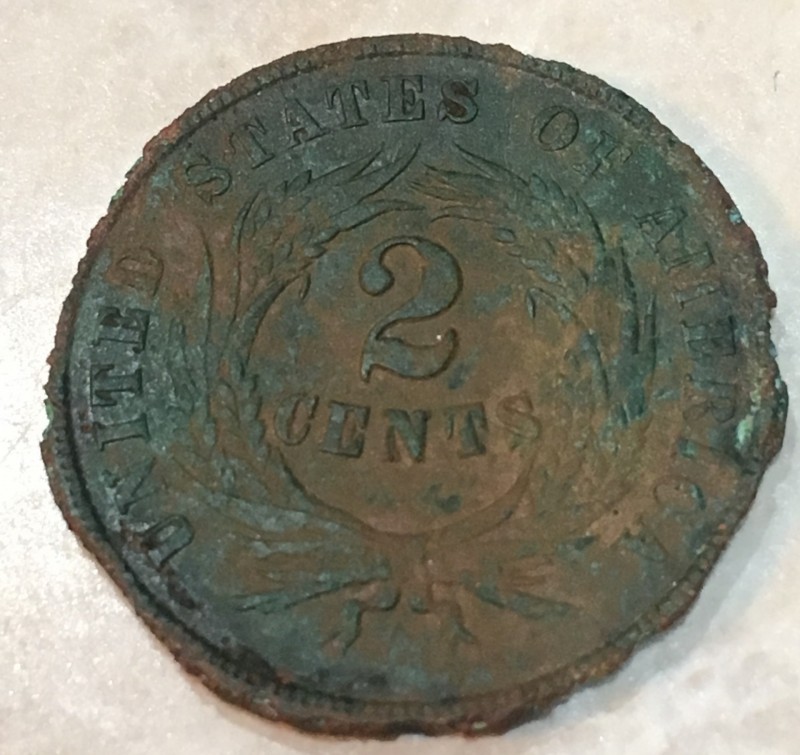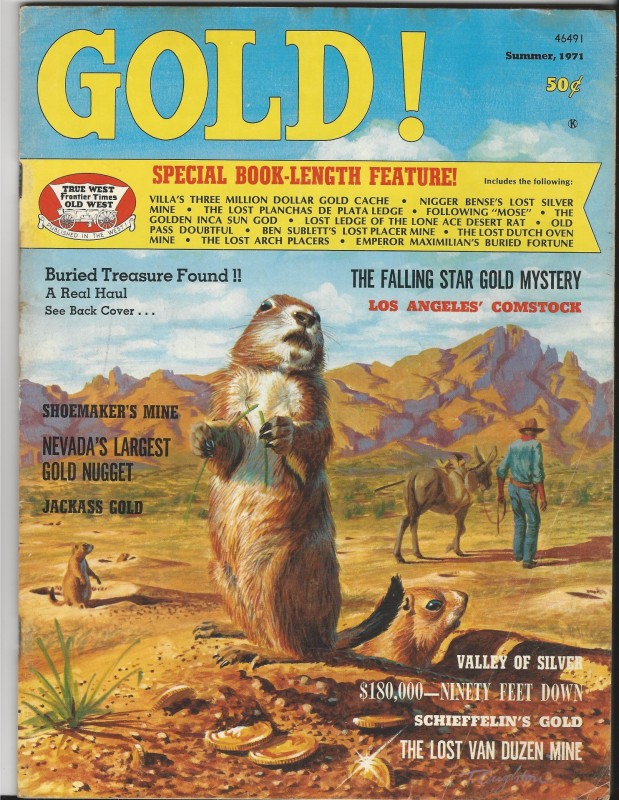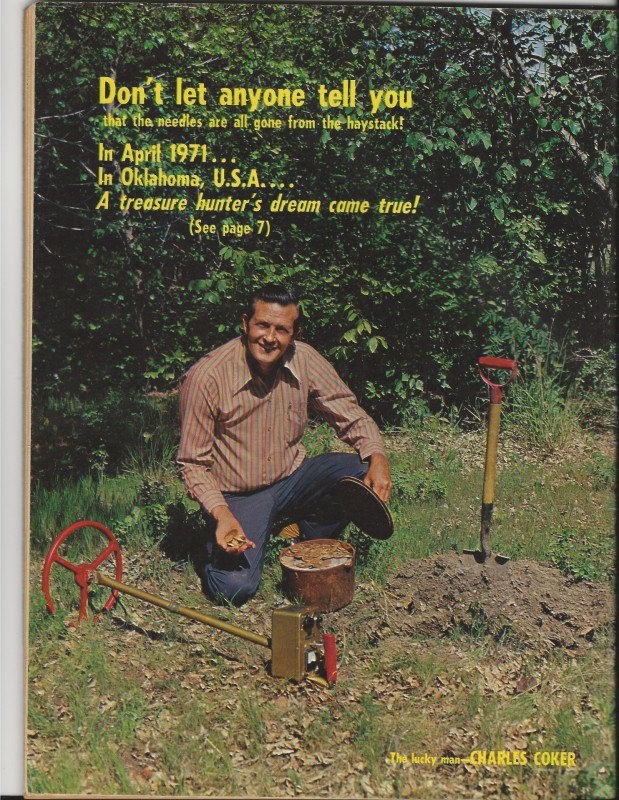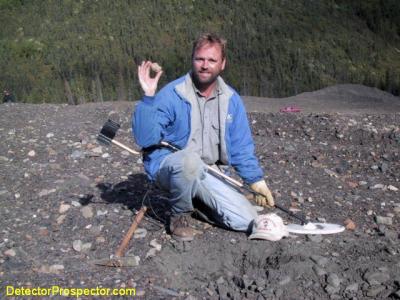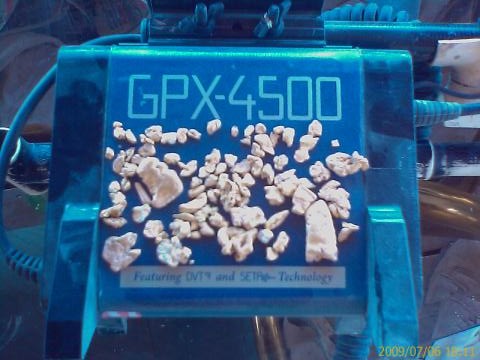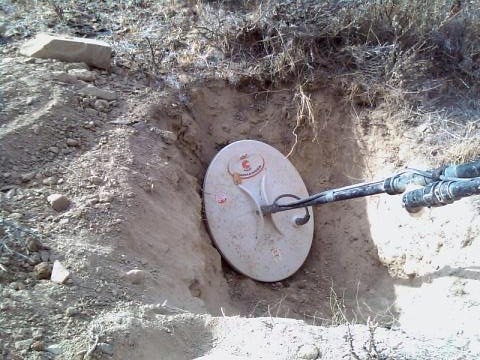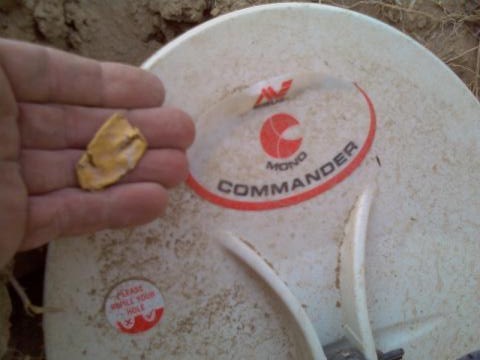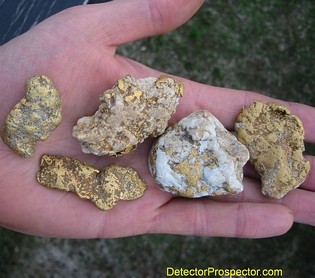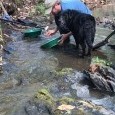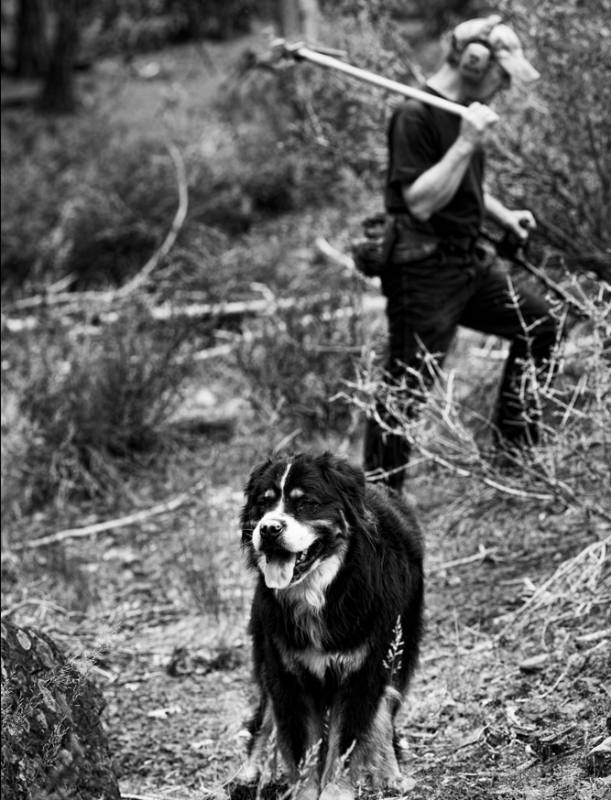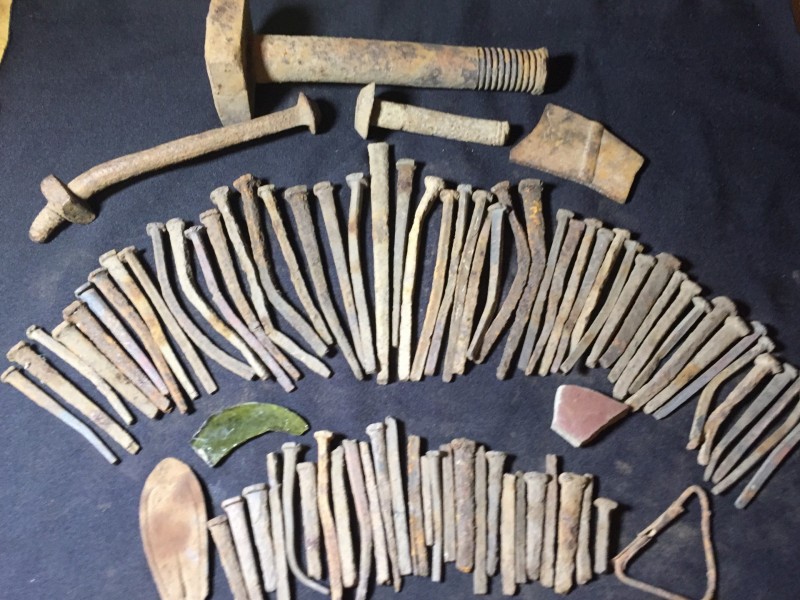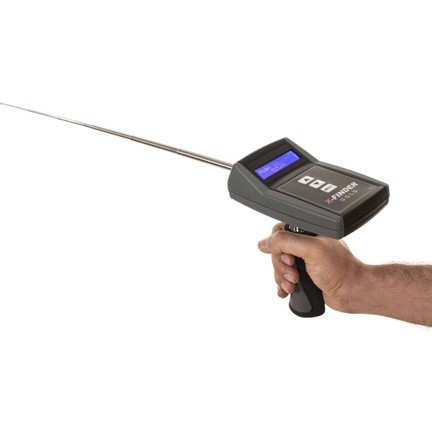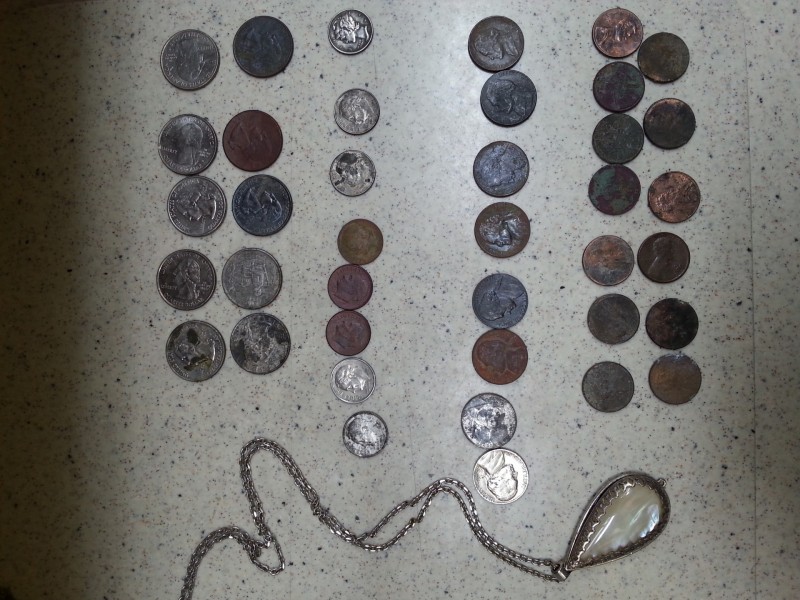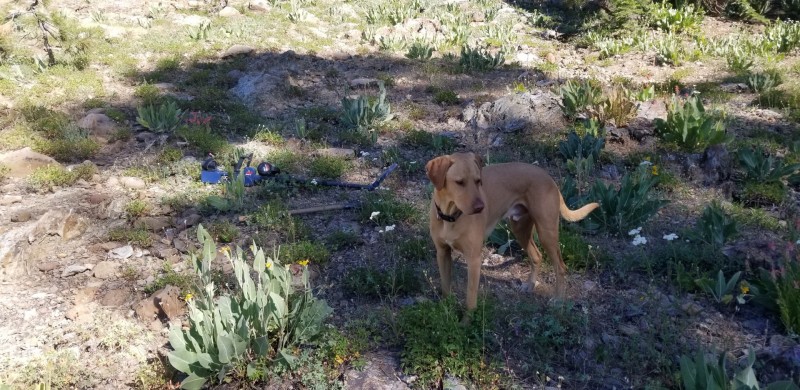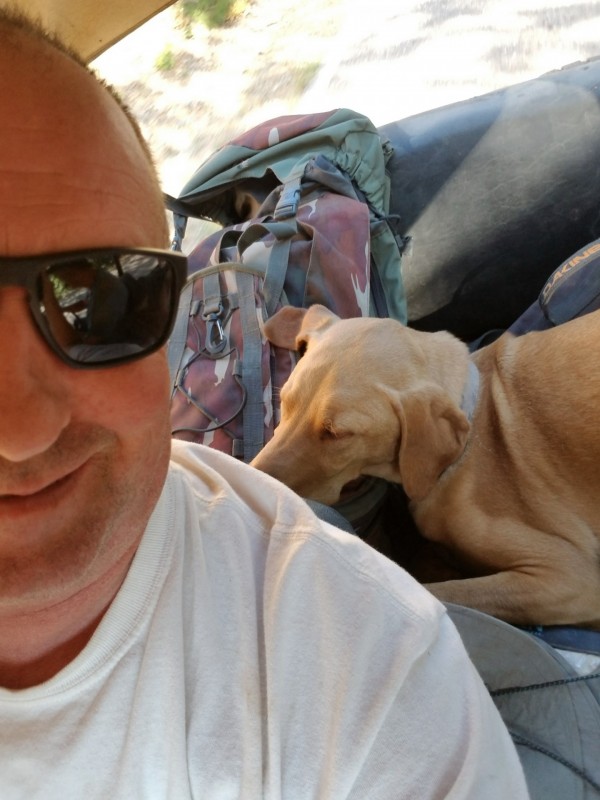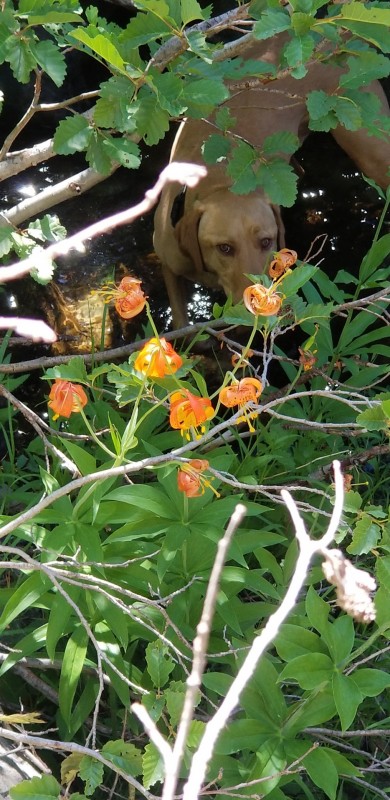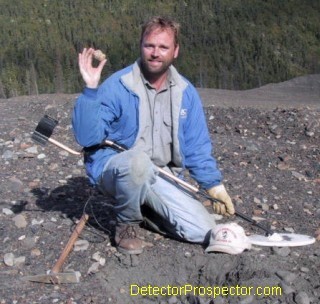Leaderboard
Popular Content
Showing content with the highest reputation on 08/25/2019 in all areas
-
I kind of hesitate to bring some of my ring finds for customers because I know some folks think that it's not hard to find a ring when someone tells you where they lost it and ringfinders like me are glorified hustlers. I wanted to share this one because it was truly a quest and the ending was worth every step and every swing of the detector in the 95 degree heat and dust. I got a call from Michael last night saying he had been helping coach his young daughters cross country team at Rancho Santa Susana park in Simi Valley. He went home without his platinum wedding ring. As fate would have it they had run all over the park (It's huge!) and even up on the hills across the street. He thought he could have lost it in the bark area, a couple grass areas, along a 2 mile path and finally the hills across the street. We started with the bark area which was about 300 yards long by 25 yards or so at it's widest. He said he had sprinted in this area with the kids and the ring may have flown off there. Unfortunately for me it didn't as I canvassed the whole area in about an hour and a half just swinging my nox while kids played soccer next to me. I was looking for that 12-13 double beep as it was going to be on the surface. I turned my sensitivity all the way down so I would only get surface signals which helped speed things up. I was also the idiot who forgot to bring water so I was starting to sweat through my clothes hoping I could hijack and unsuspecting soccer players water while they weren't looking. We finished the bark area and detected a path on the way to the grassy area #1. I gridded it, found 2 nickels that had promise given the signal I was hunting for was 12-13 nickel as that's where all my men's platinum rings have come in at. We declared grassy area #1 done and went to grassy area #2. About a half hour in I began to sense he was giving up and truthfully I was beginning to think this wasn't going to end well. I was starting to to tell him the other things he could do to find his ring(police, craigslist, pawn shop) and I had literally covered all but a 10x10 area of the grass and something told me to search it even though it really wasn't an area he thought he'd lost it at. Again I want to emphasize I felt like I was being led/pushed to go search it. I got over to it, started gridding and I got a nice double beep with a 12-13 VDI. I had my shades on so I couldn't really see the grass and I was just pulling out my Deus propointer to verify the signal when Michael reached down and started screaming "you found my ring, you found my ring!" Before I could even speak he put me into bear hug and he started shaking and crying with joy that he had his ring back. He had a hold of me for at least a minute and then we prayed, gave God thanks for the recovery and he got it back together and called his wife. If you've never found something another person has lost you're really missing out on one of the greatest experiences of your life. To me metal detecting isn't my hobby, it's my ministry. Most of my customers are women and they have a tendency to be very emotional so you can imagine I was taken aback by how important this ring was to him as he said over and over that it represented his love for his wife. Finding this ring today was a needle in the haystack recovery that God led me to. I'm not trying to get all spiritual but it's just who I am and how I roll. I hope all of you have at least half as good a weekend as I am.10 points
-
Hi All, I'm new to detecting and this group. Have only been out a few times myself looking for coins/relics/jewellery etc. I'm a bit of a shed tinkerer and decided to knock up some picks from old leaf springs from a LandCruiser. Made two different sizes. One for my older son and one for my girl. Thought I would share them with you guys. I was pretty stocked with them! Cheers PS. They do not look like this anymore... I didn't want to get them dirty at first. They were almost mounted on the wall! hahaha6 points
-
Hi All, Had a quick hunt today at an old home site. Currently a grassed park, there was a house on the site in the 1950's. I targeted the area that looked like a couple of clotheslines in the aerial. The aerial isn't of great quality so difficult to confirm. I ended up finding a couple of old lipstick tubes in the area which makes me think there may have been a couple of upturned pockets in the area (i.e. a clothesline or two). Unfortunately no coins or anything else of value... I'll be heading back there when I have grown my confidence with the machine. Cheers all Rob6 points
-
So many touching stories and memories of your 4 legged companions and even a few 2 fisted roos.. It just goes to show how attached we are to our loved ones and sometimes more than we realize. My 4 legged partner is Hero. He gets excited every time I put on my detecting cloths as he knows I'm about to head out into the field. Most times he stays home to guard the place. I do take him to Eastern Oregon so he can see his girlfriend (part wolf) on occasion. he is a medium long coat full bred German Shepherd, so he does not care for hot days much. Likes to stay in or around water. Thanks for sharing everyone and I really enjoyed this post Steve.4 points
-
Hi All, I have been trawling this site for a number of months and figured it was about time I started contributing what I can! (which is not much at this stage). I have equipped myself with an Equinox 800 and hope to be able to make the most of it! Focus will be on relics/coins/jewellery for now with a goal of heading into some gold country. Not sure the equinox will handle the hot earth of the Goldfields so there may be further acquisitions before a trip to the Goldfields. I'm enjoying hunting the parks at the moment so i'll stick with that. Thanks for all the information so far! Cheers all3 points
-
3 points
-
Those magazine illustrators really were skillful at their task, getting us to fantasize over the possibilities. Just another lost art in today's internet/social-media/cellphone/selfie photo-dominated age. Here's a slightly later issue (vol. 3, #3) from 1971. Remind anyone of Northern Nevada desert (or Southern Nevada, Northern Arizona, SE California,....? And the back cover: From the accompanying article (written by the infamous Bill Mahan, founder of D-Tex): The total count was 202x silver dollars, 79x $20 gold pieces, 53x $10 gold pieces, 43x $5 gold pieces, 2x $2.50 gold pieces. Mint dates range from 1850-1881. The detector Charles had borrowed form his dad was an old 1966 model D-Tex Standard.... He barely had a signal. It was (later) found that the battery was down to less than 4 volts. It was purly accidental that he detected anything at all. Any detectorist's bucket lister includes a gold coin. How about a cache of 177? Imagine the world-wide media attention such a 6-7 figure find would garner today.3 points
-
The pristine nails have typically Chuck - in that case those pristine nails have typically been annealed by fire (not intentionally though). They look great because the annealing inhibits the corrosion process, but are too soft to actually be used and will bend easily under a hammer. When recovering the corroded nails at archeological sites we call the severely corroded nails "cheetos". The type of nail (hand forged, machine cut (starting in the late 1700's to late 1800's), or the modern wire nail) and the type of head on the nail provides clues as to when the nail was made, what it was used for and can help you date or determine what a former structure was used for at an archeological site. When I do volunteer survey work at local historic sites, the archeologists get really excited about ferrous recoveries that detectorists typically throw in the scrap pile. I have learned a lot about what seemingingly mundane or junk targets are telling me about a site when I am detecting it for relics. It is all about doing the detective work up front and during the hunt, piecing together the back story of the site from old maps, to historical records, to the trees, water soures, and terrain to envision where the dwelling or long-term camp was likely to be located. Once you start heading in that direction, hitting the nails and/or seeing pieces of plates or pottery on the ground, you know you have arrived. That is why I always like to hear the iron when I am relic hunting and don't mind recovering the nails. Some additional info: https://www.uvm.edu/~histpres/203/nails.html https://www.harpgallery.com/library/nails.htm3 points
-
The AT Pro, AT Gold and AT Max all have Iron Audio on/off. That's the main problem for me. It should be incrementally adjustable for the detecting conditions. That is not hard to do in this day and age. Neither is overall master volume control for the AT Pro and AT Gold. Jeff2 points
-
GB, I actually have that DeTex model (see attached photos). Your magazine mentions "Nevada's Largest Gold Nugget", what exactly does it weigh and where was it found? Just love these old Treasure Magazines and their article. Busho, I have one too, but mine works like a dream. I can easily go to the mall parking lot on a Saturday afternoon and turn that baby on, guaranteed it will point to a big metal car every time. You have to believe my friend...just believe.2 points
-
Welcome to the forum! Rest assured a properly tuned metal detector will “handle” any ground. It simply requires reducing the sensitivity until the detector is stable, and then working within whatever limits that imposes. Gold can be found with most any detector if on good ground and with a skillful operator behind the machine. I am not saying all detectors are equal, but the truth is it’s the operators that vary far more than the detectors themselves. Enjoy!2 points
-
Westy 27 Yes the ID could change from air test to being in the ground. You really don’t know what’s next to your target and the minerals in the ground could effect your ID . Now this is just me ! If I was you I’d dig everything until you really knew your detector. Sometimes that trash can be a treasure . Remember if one person has been there they may have lost something . Chuck2 points
-
I think I am starting to get the hang of this metal detecting thing, and I am still learning from everyone here on what to expect out of this 800 unit. Thanks to everyone who has been helping guide me through this and yes I want to find gold everyday with it! This is where I posted Saturdays find and how long it took me. https://www.detectorprospector.com/forums/topic/10613-suggestion-for-construction-site/ Valen2 points
-
FASCINATING. Thanks for sharing, Chase. This information is very interesting, and it confirms the reason I almost NEVER find square nails in Oklahoma. Oklahoma, long the land of Native Americans resettled here in the 1830s, was not opened for "white" settlement in much of the state until 1889 to 1891. So, the "dating" of the use of nail types explains my observations quite well. Meanwhile, when hunting back home in western PA, I very frequently find the type-B "cut nail" (which I have always referred to as a "square nail.") One time here in Oklahoma however, detecting an old U.S. Military fort (1850-1870), we -- like Walter -- stumbled onto a huge cache of square nails (type B, as I now know, thanks to Chase's info). They were all in a large "bunch," and so -- while the outer ones were rusted, the "inner" nails in the bunch were quite well-preserved. It was an interesting find, for sure! Steve2 points
-
The 12x15" Semi Ellip MONO by Commander will go deeper on larger gold than the stock 11" round MONO as I have done many side by side testing. Now to be honest, I have not done a side by side with the new flat winding ELITE series against the 12x15 Commander, but I did notice more depth with the ELITE when compared to the standard 11" round MONO. As Lundy mentioned, back in the day, the 12x15" MONO Commander was my favorite coil as with many of my Field Staff Experts and we dug some really deep nuggets at Rye Patch with them. The 11" ELITE is better on the smaller nuggets though and in certain areas they are more prevalent.2 points
-
There is a prelude to this story. In mid-May my wife and I flew down to Reno for our youngest daughter's college graduation. Her older sister was also there, and the last night of our visit we went out for dinner. The place had Asian food, and we all got fortune cookies. My fortune: ''You will have gold pieces by the bushel.'' I put it in my wallet. My friends Jeff, Brian and I made a spur of the moment trip to Ganes Creek near McGrath, Alaska to metal detect for gold over the three day Memorial Day weekend. We made a similar trip last year in July, and had good luck finding gold nuggets, including the largest I've ever found, a 4.95 ounce nugget. As you may imagine, we have been anxious to make a return trip. Brian is new to detecting, so I loaned him my chest mount converted White's GMT with 14" coil for the trip. Jeff and I used Fisher Gold Bug 2 detectors, both with 14" coils. It was spring at Ganes Creek, but the weather had been hot in Alaska, and so the only ice was left on some ponds and along the creek. Daytime temps were hitting the 70's and 80's, but it was into the 40's at night. There were many fires in Alaska due to our abnormally hot, dry spring making for hazy air, and at times you could smell the smoke. The mosquitoes were not yet out in force, and head nets were not needed. Unfortunately, this is not normally the case later in the summer. Jeff went up Friday morning, and Brian and I met him Saturday morning. Brian was feeling a bit competitive and worried Jeff would get a big jump on him, but my hopes were to see a lot of gold on our arrival. I was a bit worried that perhaps our visit last year was a fluke, and that gold might be harder to find than we thought. So I was not happy when Jeff reported only one nugget for a long days hunt just upstream from where I had found the 4.95 ounce nugget last year. And only a pennyweight nugget at that. Not very promising. I had my heart set on hunting some old dragline piles next to the airstrip. We had hit them a bit last year, with no results but some trash. But I felt there had to be gold there. We had found several nuggets in the airstrip itself, including a 3.5 ounce nugget my father found. The airstrip was topped with material from this tailing pile, and so we figured the gold had come from there. We loaded up our detectors and headed off to give it a try. Tailing piles along airstrip at Ganes Creek (Brian standing in top center pile for scales) I walked up onto the pile and in ten minutes had a 1.11 ounce nugget! Jeff was amazed. He had spent a long day before looking for gold, and I score a big nugget right off the bat. That set the tone for the three days. I had numerous areas I wanted to try, pinpointed from my aerial photos. At most we hit I had the first nugget, in about ten minutes. Sometimes the other guys found gold, sometimes not. I on the other hand was unusually lucky this trip. I just kept putting my coil over the gold. Still, Jeff found his largest nugget ever this trip, a one ounce nugget not 50 feet from my first in the ''Airstrip Pile''. Brian also found his largest nugget ever, a 1.33 ounce nugget from a pile within a couple hundred feet of the camp, christened the ''Cabins Pile''. I found a 1.89 ounce nugget in this same pile. Brian with his 1.33 oz "Bear Nugget" The next day I got off to a slower start, but caught up at the very end of the day with a 2.45 ounce nugget off the ''Airstrip Pile'' down in the brush. I like hitting oddball spots, and my willingness to work in the brush paid off big time. The last day, Memorial Day, I went clear off the scales. We went over a mile upstream above the camp, and I found a .97 ounce nugget. Another tall tailing pile by the runway with the windsock stuck in it, the ''Windsock Pile'', gave me 9 nuggets, five a 1/4 ounce or better. Everywhere we went I found gold. I wanted to try the old bucketline tailings way downstream, and within ten minutes found the largest nugget of the trip, a 3.22 ounce gold/quartz specimen. Finally, trying above the cabins upstream on the tributary, Potosi Creek, got three more nuggets; 4.2 dwt., 6.0 dwt, and 11.3 dwt. Steve with 3.22 ounce gold/quartz specimen The bottom line is I could do no wrong with a detector this on this trip. Brian got 2.5 ounces, Jeff 2.8 ounces, and I ended up with an incredible 14.4 ounces! The last day alone I found 8.14 ounces of nuggets. Grand total for three people in three LONG days - 19.72 ounces. So is it all gone? Did we get it all? No way. We did not scratch the surface. Ganes Creek is vastly larger in area than you can imagine. The tailings run for miles. There are a couple areas we have given pretty good attention, but none I would not hunt again. All hunting was with the Fisher Gold Bug 2 or White's GMT with 14'' coils, with full rejection of any iron targets. Only solid good signals were dug, and all scanning was ''speed scanning''. All the areas that produced gold should produce more with careful work. All I can say now is there is plenty of gold to be found, and after everyone gets through hammering the creek this summer I will go up again this fall, and find more gold to prove it. But really, what do I think of the odds for finding gold at Ganes Creek now? Brian is relatively inexperienced compared to Jeff and I, and was learning a new detector. I'd say his finds were about on par with what I expected of him. Jeff was way off... a real cold streak. He should have found twice as much. And I was hot as could be. I found about twice what I would expect. All this is based on bare gut feelings, but I'm thinking 1 ounce a day is a sort of average. But any number of nuggets will blow that away... and bad luck could shoot anyone down. Steve shows off gold found at Ganes Creek over Memorial Day weekend Close up of the gold nuggets and specimens from Ganes Creek The big thing here is the ''nugget factor''. You can find nothing all day, then end up with a couple ounces in one nugget. I was just plain lucky in that regard. I simply happened to place my coil over more large nuggets. They add up fast, and so really get you ahead fast. So the biggest advice I have is never quit, never give up, never slow down. We put in about 15 hour days, and used them well. But if you are easily discouraged, you'll have a tough time at Ganes Creek. Persistence is the name of the game. And a good fortune cookie might help. The newer dragline/bulldozer tailings are vast in extent, and seem to have more nuggets, but more trash, than the old bucketline tailings. But I can't help but feel that really big nugget is in the bucketline tailings. They are relatively trash free, and so require real patience. You can hunt for a couple hours with hardly a signal, and those are usually large steel. It's easy to get the feeling there is not much gold in the cobble piles. But in all those cobbles I just have to believe there is a fist-sized cobble of gold/quartz lurking. Just like my 3.22 ounce piece... but larger! 2011 Update: I was right - many nuggets weighing over a pound have come from the cobble piles since. But if you do not mind more trash targets, the dragline/bulldozer piles seem to have more nuggets in general, and would be worth the most attention for most people. Steve's five largest "chunks" of gold from Ganes Creek weekend Ganes Creek is being opened to the public for the first time this year, with one week stays at the mine running $3000 per person, room and board provided. You keep all the gold you find. The largest nugget found at Ganes Creek weighed 122 ounces. For more information and photos see the Ganes Creek page here. 2011 Update: Those early days of easy pickings at Ganes Creek are gone forever. Now, ten years later the pay-to-mine operation continues. I was at Ganes for two weeks in 2011 and will be there again for two weeks in 2012. These days bulldozers are run every day to turn material over and expose new nuggets. Every nugget found is one less to be found, however, and it is getting harder to find gold at Ganes these days. In 2010 I found 6 ounces of gold in one week at Ganes Creek. My spring 2011 trip of two weeks also got me 6 ounces. A half ounce to an ounce a day average may still sound pretty good, but the fact is only a few very experienced detector operators like myself pull it off. The majority of people who visit Ganes would do better to set their sights on perhaps an ounce of gold in a week of detecting. Though big finds still happen now and then - the largest nugget found at Ganes Creek by a visitor in 2011 was a solid 10.5 ounce beauty. ~ Steve Herschbach Copyright © 2002 Herschbach Enterprises1 point
-
From back in May when i first found my little nugget patch. Some of the smaller pieces of gold in this spot would ring up to the iron side, but since almost every target in this spot is gold, it shows you that on small gold the probability indicator should be ignored. Some nice gold for only an hour or so spent detecting. Will have more videos to come, im slowly working through my backlog. Thanks for watching!1 point
-
Dragged a buddy mine to an area where I found a 2 cent. Had my Tejon with larger coil this time around and got a small but nice hit near a pine tree, told him to dig it might be good. I looked back after a few minutes and saw a huge mound of dirt so i went back and relocated it. Turned out to be a 4 leaf clover charm gold plated over zinc so I said want it? Might bring you some luck... he said no all pissed off. Continuing on i found 5 Indian heads with dates from late 1800's to 1908, pocket knife and a barber dime to top it off. The Charm is now hot glued to the Tejon 🙂 What was odd is the Indian heads showed up as a 60 on his Garrett. Really strange as they usually show up 74-76 on those machines. Even on my Tejon they were pretty much on the pull ring if not on the fringe. Usually skip those signals but for some reason they just sounded a bit better than a pull ring. Too bad the pine trees beat them up. Think a bit more baking soda and toothbrush will clean them up a bit more.1 point
-
1 point
-
Thanks for the kind words but I really don't want them to be about me but rather what an awesome hobby we have in detecting. I can think of no other hobby where you can find money, history, jewelry, gold AND make others happy in the process. GB is right in that the folks here are the best and thanks to Steve and his ability to shut some things down it has and continues to be the best place to share and talk detecting. To be alive is to be making a difference and man I felt alive yesterday!1 point
-
Wow. I don't want to dampen your enthusiasm for your newfound passion, but, frankly, I would slow down on the coil acquisition and focus on learning your new detectors with a minimal of variables at this point (i.e. different coils). It seems you are just starting out with PI prospecting detecting (if not detecting in general) but it is not clear to me your background as a prospecting detectorist is with your VHF 800 and Gold Monster detectors so ignore the following if it is stuff you already know and I will just put it out there for anyone else new to the hobby in general. Remember Steve's words of wisdom earlier in this thread: "People go chasing off after coils way to soon in a lot of cases when simply mastering what they have would be more productive." My advice to you is to just get out there and start learning your new detectors with the stock coils. There is a lot to learn just on setting up soil timings and learning nuances of the audio language of the GPX...and the GPZ is a completely different beast. They are both very different than the VHF detectors you may be used to. Mixing it up with all these coils, you'll be spending more time loosening and adjusting coil bolts and cords than getting quality detect time training your brain on a consistent baseline coil audio response to various targets. From that you can start to gradually learn how additional coil types sound and purchase coils on the basis of what they can actually bring to the table in terms of filling the target/capability gaps of your existing coil(s). All these coils will make the GPX sound and behave slightly differently even with the same exact detector settings. Avoid the temptation to be enamored of all the bright shiny hardware accessories and user claims of this and that until you get a handle on your detector, your sites, and the targets that reside there [you may already have]. Not sure if this applies to you, but for those new to the hobby, detecting takes a lot of patience, target acquisition and recovery is not all that easy (at least not as easy as the skillfully edited You Tube videos would lead you to believe) and before you invest TOO heavily, it is wise to make sure it is something you are going to enjoy for years to come. I have seen many folks get frustrated and quit the hobby because they spent too much time wrestling with an overwhelming mass of hardware that they could not master. Keep the detector piece as simple as possible when starting out. Though it seems resources are not an issue for you, just know that standalone coils, especially specialty coils tend to not hold their resale value as well as detectors. So be cautious in investing in coils you may not even need as your return on investment may be pretty low. Regardless, have fun with your new equipment, but focus on learning those new detectors at this point and the best way to do that is minimize the variables that can reset your learning curve like too many coils. There will be plenty of time in the future to acquire new hardware, it ain't going anywhere, will probably only get better, and frankly 90% of success in detecting is getting yourself onto a good site where the targets reside, knowing how to attack that site, and gaining field experience. After that, the equipment's effect on success is really about splitting hairs and the perceived performance deltas come from our obsessive-compulsive personality disorders that make us think that the equipment really makes that big a difference. I mean, who doesn't like to buy more tools just because they're cool and not because we need them. GL HH.1 point
-
Excellent conclusion. Two (old) lipstick tubes close to each other is a good indication of a clothesline, although not a guarantee. I've done well under clotheslines. Most of my old coin and relic finds have been from parks which were formed in the last 50 years but were homesteads prior to that. This includes one Mexican War button (mid 1840's), one Civil War button and a CW cartridge box plate. I've just recently been searching another park which had an 1892 built home torn down in 1969. Still haven't found the sweet spot on that one but I'm not discouraged.1 point
-
That may be true of concentric coils, but that's not how a DD coil works (which is what the Equinox uses). On a DD coil, the active detect region is beneath the center spine area where the two "D" coils intersect. Although you may have some edge sensitivity effects that can affect overall sensitivity and coil overload in thick target situations with larger DD coils, the target recovery time is determined by the detector solely, and the center spine strip thickness (the overlap region) and sweep speed determine how long the target remains in the thin overlap region which is basically the same thickness for all three Equinox coils. Although you could have a situation where more than one target ends up under the active region center strip, recovery speed does nothing for you in that situation because both targets are simultaneously under the active region, you are just less likely to have that happen with a smaller dismeter, shorter length coil. Equinox DD coil diameter or length/width for the large Elliptical coil) primarily affects depth and sweep coverage and ability to sweep the coil side-to-side in tight confines and has nothing to do with recovery speed based target separation. See this thread for more information on DD vs. Concentric coils.1 point
-
I prefer the rounds mate on the GPX's. They go deeper. Full stop. Large round in the more open areas, the smaller in the scrubby stuff. Have not used the 14 x 9. But the 17 didn't impress me so I guess I'd be equally unimpressed by the 14. That's me though, some people love them on the GPXs, I dont. I like them on VLFs for wierd little specie stuff but never have on any of the SDs, GPs, or GPX's.1 point
-
Given that FT gave the world a “peek” at the AQ last spring at the outdoor “Messe” in Germany, I tend to doubt that they would want to have it appear at Detectival or any of the other rallies in Europe this September. It isn’t ready for release - we know that because it isn’t released. Showing it anywhere else would likely just stir up questions.1 point
-
Westy27 Don’t give up on anyplace until you hunt it . If you live in a city that has buses then you want to hunt the bus stops. They can produce more than most think they would. You said the house dates back to the 50’s. Then you should find silver there. Don’t give up and keep telling yourself that. Chuck1 point
-
I've been metal detecting with my Minelab Equinox 800 all summer sine getting it in April 2018, but just finding the usual coins and nothing exciting to post. The last several days outside Reno I made it out to a new site and found a cache of 75 square(actually rectangle) cut nails and some other interesting items. One item appears to be the end of an old spoon. Using Field 1 pretty much factory settings, but when in town and hunting parks I lower recovery speed down to 3 and slow speed rate speed way down . ( I find gets better depth) . Also, switch target zones to 5 to get more different sounds on the various targets. For the first 1 and 1/2 years of using the Equinox I used Park 1 all the time, but after getting more experienced with it, help from this forum, and reading a couple of books on the NOX( Clive James Clynick and Andy Sabisch books) I feel comfortable enough using some other modes and changing the factory settings. After using a Whites XLT for 15 years it definitely was a learning curve with he NOX , but well worth the learning process. Now, up to 1061 coins and $71.16 for 2019 including the water/sand finds with another detector. (including 9 wheat cents). The forum does great job of speeding up the learning process. Great day in the field.1 point
-
1 point
-
This is what I have found in just 3 hours today after I mowed the yard. I just got back and ran some water over this batch of finds and patted them dry. I found so many rusted nuts and bolts I lost count. Those rang up as a solid 12 so I dug them thinking of a nickel. The chain that I found is Silver and has Mother of Pearl in a tear drop shape and that was the first thing that I hit. Who would have thought that it was sitting right on top of the soil and not in bad shape. I did place it in my ultrasonic jewelry cleaner and I think it came out fairly nice. The coins were found within 2 to 4 inches deep since the grass was removed. I have not yet searched more than a third of the area yet due to all the hits I had, so tomorrow I will be back there again. Valen1 point
-
Those are some nice chunky gold nuggets you saved. Very nice photos and story to add. Thanks for sharing and wishing you the best with the new one coming.1 point
-
Totally agree, Jeff regarding audio and iron performance. Very capable detectors. And the AT Pro was a groundbreaking detector in its day. Glad Garrett improved the visual interface somewhat on the Max. Garrett bumped up the gain (which frankly has caused it to be more chatty than deeper, necessitating a gain reduction back to Pro levels so what was actually gained?) and claims of 50% depth increase (especially without specifics) should be taken with a grain of salt considering that there was no compelling technological breakthrough going on other than the gain increase. The frequency shift from 15 to 13.6 khz was insignificant from a performance standpoint. Garrett should have instead focused on improving the overall audio, audio ID and iron audio capabilities, perhaps providing multiple selectable operating frequencies (not just frequency shifting) and perhaps improving or providing adjustable recovery which hinders its ability in thick iron and trash and at mineralized sites. Hope Garrett wakes up and starts working on what it needs to do to be competitive with the Nokta/Macros, Minelabs, and XPs of the world with its next generation. A warmed over AT series detector for the next iteration is just not going to cut it. Their ability to be competitive, and more importantly innovative, again, would only be a good thing for the hobby.1 point
-
This site has a pretty powerful yet easy to use advanced search feature which is needed because of the troves of valuable info stashed here and there. Hope this link helps answer your question. But what it boils down to is that the 5000 has a couple of additional timings for salt and mineralized soils and a couple of extra custom presets. Other than that, performance-wise they are about the same.1 point
-
Funny you should mention that. There was some evidence of a campfire or some other type of fire at the site including some pieces of melted glass. As always, thanks to everyone for the added information about square cut nails and comments. Good hunting!1 point
-
I have owned the AT Pro and AT Gold along with getting to use the newer AT Max too for some testing. I really like all three detectors and I could easily put all three in the very good to excellent category except for one area (for me personally) of the feature set that is lacking. There are not enough audio features on the AT series for me. Three tone audio which is somewhat adjustable, no volume control on the Pro and the Gold, and no Iron audio volume control on the Gold and the Max make it hard for me to fully enjoy these detectors in moderate to heavy iron and moderate to heavy mineralized detecting areas. So, yes the AT series are good detectors, no doubt, but for the money, especially the Gold and Max, they could be so much better with some more modern, upgraded audio capabilities which the competition has had for many years already. Jeff1 point
-
Good stuff. I think all the ones I've found are Type B. I assume the terminal dates of use are only approximate. My uncle (a home builder) not only reused wood from demolitions but also nails, having lived through the great depression when almost nothing of any usefulness was thrown away. I wish I had asked him if he ever (re)used square nails. Also, if he had somehow come upon a keg of virgin square nails I have a feeling he would have found a way to use them. I found revealing these two similar statements from the two articles: Cut nails are still made today, however, with the type B method. These are commonly used for fastening hardwood flooring and for various other specialty uses. Machinery was developed to produce cut nails in the 1900's, and they are still used in flooring and concrete applications, where holding power is paramount, and power nailing tools are standard. Machine made cut nails are also made for use in reproduction or hobbyist replica furniture, but they are so perfect and identical that it is usually easy to see that they are new. From the second excerpt, it appears that the square nails in current use can easily be distinguished from the antique varieties. I certainly hope that is the case.1 point
-
Most square nails I find here in Indiana are severly rusted (globs of rust stuck to them) but recogizable. Sometimes, though, they are pristine other than their dark color. I suspect different nails have different treatments and also different alloy compositions. Interesting find.1 point
-
Does anyone know if an 800 will connect to a phone or any other Bluetooth app or device that records video or audio? It sure would be interesting to record directly from the detector. I guess the best way is the old way of just putting the sound on the detector speaker and then capture the event that way. Mitchel1 point
-
Steve, you would typically have to use a field mixer to do this before feeding it into the camera audio input or mike jack, unless you had a video camera with on board audio mixing and two audio inputs or a microphone with a built-in line level mixer. Otherwise you could separately record the live voice over narration audio (with another camera or digital recorder) and lay it on top of the video and detector audio in post production using a video editing program (since the canera is not trained on you while you are doing live narration, getting the audio to line up exactly is not critical). I have done a lot of event videography (weddings, graduations, recitals, etc.) with decent mid-range videography equipment. But I am such a perfectionist when it comes to that stuff, I would be fiddling with all that video gear that I wouldn't be able to focus on detecting, so I have made very few live detecting videos. For Equinox, I would probably rig up an external speaker connected to the headphone jack and allow the camera mic to just pick up my voice and the speaker audio of the detector whike I listened to the tones through my BT headphones. Alternatively, I could feed the detector audio into a BT APTX LL receiver with a clip on speaker/mic plugged into the receiver and the speaker/mic clipped to my shirt or jacket that way I can hear the detector audio and the camera mic could also pick it up along with my voice commentary. HTH1 point
-
Besides latency, the other issue with using a wireless receiver as the source for your recorded audio is how do YOU hear the detector itself while recording, since the control head on-board speaker is cut out whenever you are using wireless audio. So here are some strange Equinox wireless audio fun facts that may provide some folks with alternative ideas to route "auxiliary" sources of "no latency" detector audio out to video or audio recording devices (or detecting "partners") instead of having to inconveniently capture lower fidelity audio from the control head loudspeaker so both you and the camera or your "partner" can hear the audio simultaneously. Many folks don't know this, but if you are using the BT headphones or the WM08 receiver, the control head speaker audio is cut out, but the headphone jack audio is still active. In this manner you can actually use the BT headphones to be able to hear tones yourself and you can route hardwired audio from the headphone jack via a mini-patch cable into a camera mounted on your detector shaft, detector housing, or mounted on your hat, backpack, or clothing. Another way this "feature" can be "used" is to enable a partner to hear the audio via the BT headphones while you swing and simultaneously listen to the audio using a pair of hardwired phones which can be useful in helping someone else walk along and learn how to use the Equinox. Another strange thing is that if you are using the supplied BT headphones, which also have a "hard wired" headphone jack on one earcup, is that you can actually use the headphones as a BT receiver and you can plug a separate set of hard-wired stereo headphones or earbuds into the headphone jack of the BT headphones and get audio that way. In this way you can "rest" the BT headphones around your neck/shoulders while using a set of wired earbuds. Not too practical, but it can be done if you want to use more comfortable wired earbuds in hot weather- though the bulky full-sized BT headphones are still resting on your shoulders/neck (I can't recall as I type this whether the BT headphone speakers are cut out if you do this, but I do think that is the case). Also, although only one set of BT headphones or a single BT receiver can be used in conjunction with the Equinox's BT transmitter output at any time, however, up to four separate WM08 Wi-Stream modules can be simultaneously paired with the Equinox at any time for small, four-person "group" Equinox instruction opportunities. Though, good luck getting your hands on four WM08 receivers at any one time unless you can borrow them from four Equinox 800 owners, because they are cost-prohibitive to be obtained as stand alone wireless accessories. All strange but true wireless Equinox audio factoids.1 point
-
1 point
-
I was in the same place you are a few months ago. I have learned a ton here as well. My best advice is read lots to learn but keep the actual detecting simple. Just use the default settings, noise cancel, ground balance if needed, adjust the sensitivity down enough so you dont have constant chatter, and just detect. Listen closely to the target, then dig it up and see what it is. Pretty soon you will be guessing what's down there before you dig like the rest of us (and be wrong fairly often like the rest of us 😀)1 point
-
I will honestly say I had a Vaquero for over a year and could actually hear and know pencils eraser ends before digging. I've always thought Tesoro's had one of the best if not the very best audio in the detector industry.1 point
-
After having bought and used a Minelab Equinox 800 for more than 80 hours/ 1 year, I bought a Garrett AT Max as well. The AT Max is my favourite detector now. Don't get me wrong, the Equinox is a very very good detector in my opinion and I'm keeping it for sure. However I can not really get used to the "tight" vdi scale of -9 to 40. I prefer a vdi scale of 0 to 99. And the handle/straight-stem combination causes my arm (elbow/shoulder) to hurt some after even half an hour. No problems with the S-stems of my other two detectors. But most importantly (for me personally) the AT Max has something extra, that I have never experienced with another brand of detector, namely: FUN. It's hard to describe why or how, but just looking at it and using the AT Max gives me joy. And every time the Max connects immediately with the MS-3 headphones (or my Z-Lynk receiver for use with my XP backphones) and the wireless AT Z-Lynk pinpointer. BTW, this "FUN-factor" is not advertised by Garrett, but you get it nevertheless and for free. 😉 I think (and it's just my personal opinion, others may have a completely different opinion of course) the Equinox is more technically advanced and adjustable to personal preferences. More frequencies and also simultaneous frequencies will give me more confidence of being able to adjust everything to the "max" (with the Eqx instead of the Max 😀) while prospecting or searching around salt water. The Equinox has everything I want in a detector, but , since I bought the AT Max, I find myself taking out the AT Max to the fields and parks every time. On topic: Garrett AT Series That Good? : ( for me) YES! I suppose, now I'm a Garrett-fanboy, as well as an Equinox-fanboy. 😁1 point
-
Yeah, I have a brass probe, but not a Garrett one. Mine is half that. Its a brass rod stuck in plastic, hard to get wrong I figured, bought the cheapest version on Amazon.1 point
-
I don't remember that specific ad but there were multiple 'build your own' articles you could start from scratch, as well as a few kits. See this thread where I pictured my (broken) Heathkit GD-48. (See this Findmall thread where someone posted a tantalizing but incomplete schematic. Phrunt will be building one, now. 😁 Link deleted since Findmall Forum update broke all old links . Those come up on Ebay frequently. Apparently injection molded plastics were still in their infancy(?) since the housings (control unit and searchcoil) were flimsy and broke easily.1 point
-
I have one as holes are not allowed in the parks in my city, just popping with a screwdriver. I use the probe to find the object first. I'm not talented at it AT ALL yet. Honestly unless I cheat and cut the turf with a pocketknife first it hurts my hands. I've mostly gone other places.1 point
-
Welcome to the forum Joe If the machine is going to be used 99% of the time doing other things, why do you need it? The machines you have are fine for such minimal use. Your Equinox 600 with 6” coil in Field Mode 2 and all metal/horseshoe engaged will be very close to the Gold Bug Pro in performance. Both are just slightly better than a properly tuned T2 with small coil. Basically you have three detectors that are very close in performance and you are just splitting hairs as to which may be the best. Everyone has favorites and you can collect opinions all week long, but the truth is I personally could use any one of them or a dozen other VLF detectors and go find gold. It’s not the tiny difference between this hot VLF or that hot VLF that will make the difference, it is your access to good gold bearing ground and your knowledge of the machine you use that will make the difference between success or failure. Bottom line is the Gold Bug Pro is a very simple to use and very well proven detector. If you can’t find gold with it, find better ground and work on your detecting skills. But I could say the same of the other two machines you already own also. As far as Equinox goes, the 600 is nearly as good as the 800 for nugget detecting. I advise either Park 2 or Field 2, not Park 1 as mentioned by the earlier poster. I am sure I am one of the few that’s actually put it to the test and most people just assume the 600 is not near the gold finding machine as the 800 simply because the 800 has a “Gold Mode” and the 600 does not. From my article at https://www.detectorprospector.com/forums/topic/6799-equinox-800-gold-nugget-detecting-tips/ Note: the following works as well on both Equinox 600 and Equinox 800. Since Gold Mode lacks target tones, going to Field 2 and using the solutions above plus the additional possibility of tones is another alternative. Instead of using Gold Mode and blocking the lowest target id numbers they can be left open to signal as ferrous or mixed ferrous targets. And you now have 5, 10, and 15 kHz options that Gold Mode lacks. Be very careful because the default rejection pattern for Field 2 rejects target id 1 and 2. This will reject most small gold nugget readings and reduce signal strength on larger gold by blocking part of the signal. Field 2 set up properly is quite close to Gold Mode performance and a perfectly acceptable nugget detecting alternative. Field Mode 2 Frequency: Multi Ground Balance: Auto (Ground pump method) Sensitivity: 18 - 23 Recovery Speed: 4 - 6 (default is 7) Iron Bias: 0 Accept/Reject: Everything accepted, rely on tones (alternative reject -9, -8, and -7 if too much ground feedback) There are so many decent VLF detectors you can use now it’s like asking which computer you can get to best run Microsoft Word. I see minimal difference in actual gold found between a 1995 Fisher Gold Bug 2 and any competitive machine made since. The VLF tech flatlined some time ago and from my perspective everything since is just different flavors of ice cream. All tasty but none all that much superior to the others. The operator in my opinion makes the difference in all the ways that matter. Best of luck to you no matter what detector you choose to use. Steve's Guide to Gold Nugget Detectors1 point
-
My father, two friends, and I flew northwest to the Interior Alaska town of McGrath Friday morning. I have permission to hunt several creeks in the area, but have had a hard time getting there the last couple summers. Bad weather or scheduling has kept me away. Everything finally came together this year, so off we went. My father is a classic Alaska bush pilot with a Cessna 206, so I'm luckier than most when it comes to access. The destination for this trip was Ganes Creek, owned by Doug Clark and Dan Wiltz. Ganes Creek has produced over 250,000 ounces of gold, and some of the largest gold nuggets ever found in Alaska. Some very large nuggets have been found here with metal detectors, and I have wanted to visit the creek for years. After reaching the mine and settling in, Doug pointed us to some old tailing piles. A friend of his, who knew little of detecting, had found a half-ounce nugget in the vicinity, so it seemed a good place to start. I had brought my Minelab SD2200D along, but found the ground to have low mineralization. Bedrock around McGrath is mainly slate/shale. There are lots of igneous cobbles in the overburden, but nothing real hot. Easy detecting ground. The main problem with the tailings was lots of iron trash. I decided to give my Fisher Gold Bug 2 with 14'' coil a try. Since we were hoping for large nuggets, I put it in Iron ID mode, which I normally have not used before. I did find that the machine chattered a lot until I turned the threshold knob down. It appears the threshold control does affect the machine in the iron id mode, although you cannot actually hear the threshold. Tailing Piles Along Ganes Creek Everyone else was using the Tesoro Lobo SuperTRAQ, all outfitted with the 11'' DD coil. Again, due to iron trash, they all ran the discriminate mode instead of all-metal. The Lobo is one of the rare nugget detectors with a full range discriminator. This proved valuable this trip. The control is adjustable, and it is very important that it be set no higher than needed to tune out nails and other small iron items. We ended up finding all the nuggets on this trip while employing iron discrimination. Our theory was simple. There were large nuggets in the area, and we wanted them. Tuning up for the little ones was not the idea. In fact, no one wanted to waste time trying to recover small nuggets and digging lots of worthless iron trash would definitely be a waste of time. I started chasing gold in the early seventies. I've dredged and detected all over Alaska, but spent most of my time in areas where large nuggets are rare. I've always wanted to find a big one, something over an ounce, but it has eluded me. I have made numerous detecting trips to large nugget locales, and detected literally pounds of gold over the years. I have no problem finding 5-7 pennyweight nuggets, but nothing larger has come my way. I finally dredged a .98 ounce nugget in 1998 at Crow Creek Mine, but even then felt like I had not really done it. .98 ounce is close enough to generally say I found a 1 ounce nugget, and I do. But I still did not feel I had hit the big one. So I went ahead and decided to back off on spending so much time dredging, to spend the time chasing hot areas to detect for large gold. A trip to the Wrangell Mountains last year netted me an 8 dwt nugget, my largest with a detector. Then off to the Fortymile last fall. That expedition turned up a 3/4 ounce nugget. Things were looking up. So this adventure was a part of my new game plan. Big nuggets the goal... heck with the little ones! Bud, Steve, Brian, and Jeff My father is always game to go mining, but does not have my passion or patience for it. I bought him a Lobo last year, as the automatic ground balance is right up his alley. The machine is very forgiving. Still, he has sloppy habits, mainly a very poor swing. He is only near the ground directly in front of his feet. I've tried to get him to do better, to no avail. We've searched lots of tailing piles before, with little success. We all start detecting, and in less than 15 minutes Dad gets a beep and kicks the ground. In a very surprised voice, he exclaims, ''I'll be damned... I found a gold nugget!'' There lay a nice 13.1 dwt piece, his largest ever. That got us fired up!. It was the end of the day, but in short order I found a 7.5 dwt nugget, a 1.1 dwt nugget, and .7 dwt nugget. Jeff hit a 2.6 dwt piece. We got some sleep, figuring to strike it rich the second day. But it was not as hot as we had thought. About noon I finally found a quartzy 14 dwt nugget. Since these are nuggets lost by the original operations, many of them have lots of quartz. The nuggets with higher gold content were generally caught. I found a 1.8 dwt, and Jeff hit a 1.3 dwt piece, but nobody else had any luck by 2PM. It was sunny and about 90 degrees. We are not used to such temperatures in Alaska, and everyone of us was suffering. Dad, Brian, and Jeff rolled up and announced it was time to head back to camp for a break. ''Leave me here; I want to keep hunting'' was my reply. Jeff decided to keep hunting. Dad and Brian gave in and decided to stay, but sat down to rest. Jeff and I hit the tailings again, and in maybe 20 minutes Jeff found a nice solid 17 dwt nugget. This rejuvenated the troops and the hunt was back on! Jeff With 17 dwt Nugget Found With Tesoro Lobo We wandered down back trails through the tailing piles, and Jeff finds another 5.6 dwt nugget. Some time later we were detecting some tailings next to the creek, and I hit a nice 15 dwt piece. Jeff and I are pretty happy at this point, but Dad and Brian had no gold for the day. Brian had not found any gold at all yet, and this can be very hard on someone relatively new to nugget detecting. It was nothing but bad luck, as he basically was doing everything right. He simply had not put the coil over a nugget yet. After dinner Brian, Jeff, and I headed for the tailings off the end of the runway. After less than an hour, the mosquitoes were bothering me enough that I headed back out to the runway. Nobody was in sight, so I wandered down the shoulder of the runway swinging my detector. The runway is made out of flattened tailings, so I figured it was worth a shot. Besides, there were fewer mosquitoes in the open! One hundred feet down the runway I get a beep and a 1.7 dwt quartz pebble with a couple chunks of gold in it. I met Brian and Jeff back at camp; they had found no gold. My father returned from exploring up the creek. He also found no gold. Steve With 14 dwt Nugget Found With Gold Bug 2 The third and final full day started with rain. We did some exploring upstream, but with no success. The mosquitoes were out in force, so Jeff and I donned headnets and searched more tailing piles. Dad explored up a side creek, while Brian indicated he wanted to search in the camp vicinity. The rain let up, but not the mosquitoes. They liked the cooler, damper conditions. Jeff and I searched tailings without luck for some time. We finally wandered back to the runway. Jeff finally picked up a couple nuggets on the runway shoulder near where I found the one the day before. I then hit a nice one also. Jeff was hot to get with it, but I convinced him we should go find our partners and tell them about the new finds. I was anxious for Brian to find a nugget. As we got to camp, up wanders Brian with a big grin. He had obviously found gold. A beautiful 7.8 dwt nugget that everyone agreed was the best looking nugget found. Solid gold with just a spot of quartz, and a bit of twisted wire appearance. The find really raised Brian's spirits, and he was raring to go now. Brian's 7.8 dwt Gold Nugget My father was way up a side creek exploring, so we hooked up with the Doug and his crew and did a little instructional detecting. They were getting the idea that maybe these things were good for something after all. My father wandered up as the group headed up the creek. He said he was too tired to go with us, but when I mentioned we had found some nuggets on the end of the runway, he decided to head that way. Jeff could hardly stand it, but we wanted to spend the time with the miners in appreciation of the opportunity they had given us. We finally explained we wanted to go try the end of the runway, and headed that way. We asked Dad how he had done. He says, ''Well, I found one. It's ugly, but kind of heavy. Maybe it weighs an ounce''. He pulls a palm-sized nugget out of his pocket. Our eyes grew wide and we explained to him that the nugget was at least 2-3 ounces. It had a lot of quartz, so it was hard to tell. It turned out to weigh 3.5 ounce. Unfortunately, it appeared to have been run over by a bulldozer. One edge was a clean break with ragged edges of gold hanging out. It is hard to tell, but I'm guessing it is one half of a 7 ounce nugget. Bud excavating a target - is it a bullet or a gold nugget? Gold nuggets Bud found with Tesoro Lobo ST at Ganes Creek We figured the other half was waiting to be found. It was also our last full day, as we were flying back around noon the next day, so we detected late into the evening. All told, we found about 15 nuggets in the runway material, mostly in one area. Brian found a second nugget weighing 2.4 dwt. I ended up with five nice nuggets ranging from 1.3 to 7.5 dwt. Jeff found six from .9 to 4.5 dwt. But we did not find the other half of that big nugget. It was late, so off to bed. Everyone had gold; Brian’s was the biggest he had ever found, Jeff’s was his largest, and my father had hit the jackpot. I was happy, but my largest nugget was a tie for the one I detected in the Fortymile, and still not larger than that .98 ounce nugget I had dredged. Jeff was also been hoping for something over an ounce, but at this point time was running out. I slept poorly that night, waking constantly. I woke a 4AM, and after an hour awake decided to get up. It was light (all night this time of year) and time passes slowly staring at the ceiling. I figured I might as well do a little detecting while I waited for everyone else to get up around 7AM. I wandered off up the creek, mainly wanting to get far enough away so as not to disturb anyone. I went to the first big tailing pile I came to, and covered it pretty well. Nothing at all. So I wandered up the road a bit, and came to a wide set of tailings that appeared to have been pushed up in a pile by a bulldozer. From the looks of it a sluice had been set up, and the bulldozer was pushing tailings to one side. I started scanning along, and near the top of the pile got a strong signal. I dug it up, and peeking out of the soil lay a little gold potato! I gazed at it in disbelief, and picked it up. It was caked in dark soil, but I knew I had finally found the big one I had been looking for all these years! 4.95 ounce nugget found by Steve at Ganes Creek It was still only about 6AM, so I looked an hour longer. I did find another 2.9 dwt nugget a few feet away, but that seemed to be it for this pile of dirt. About 7AM I headed back to camp. Dad and Brian were up, but Jeff was still snoozing away. We got him up, and I did show and tell with the nugget. After washing it up, it came up at 4.95 ounces on the scale. Literally the find of a lifetime, as no other nugget will mean as much to me as this one does. I showed the guys where I had found the nugget, took some photos, and started packing up to leave. I decided I was perfectly content to kick back and relax. The rest of my crew searched my magic tailing pile for a while, but did not find anything. Maybe my find was luckier than I know. In any case, they headed back to the end of the airstrip to search, but only Jeff found a nugget, 1.5 dwt and the last of the trip. Time to go home, so we packed up and flew back to Anchorage. I’m back to work now, and it is hard to believe I found that nugget just yesterday morning. In retrospect, what was so wild about the whole thing was that I had essentially given up on finding the big one this trip as we were basically out of time. Talk about the early bird catching the worm! I found every nugget but one with my Gold Bug 2 set in Iron ID mode. It ignored most trash except for old rusted cans and larger steel items, such as oversized bolts. I dug a pocketful of bullets and shell casings, but they were not so common as to be annoying. I did run my batteries dead at one point, and spares were at camp, so I fired up the SD2200D and found one nugget with it. A nice 1/4 oz nugget at about a foot. But I soon grew frustrated digging trash, sometimes at extreme depth. I have been getting pretty good at reading targets with the SD, but it is nowhere near as good at discrimination as other detectors. I was happy to put new batteries in the Bug and get back to using it. 18.5 Ounces of Nuggets Detected Ganes Creek, Alaska For the low mineral ground we were in, and the desired goal... pennyweight plus nuggets, any good discriminating detector will do the job. My Gold Bug 2 worked well and the Lobo did a great job for the other guys, and is a hard machine to beat for all-around detecting. But all in all, the name of the game on this trip was ''keep your coil low, and keep it moving''! ~ Steve Herschbach Copyright © 2001 Herschbach Enterprises1 point
-
The two prominent Trails into the Klondike interior were originated thru Skagway and Valdez Alaska, I guess I had been inadvertently studying these trails for many years, as I was very interested in this Gold Rush, the antics of some of the characters involved and of course the many waypoints they established...After some thought I decided the Chilcoot trail was to far away for me to ever spend much time looking, but the Valdez trail basically came thru my own back yard...I poured over books written by these characters and it was quite an interesting education....I'm not going to get into that part too much as it is a lot to talk about so I will confine this into the area that is close to my home in Copper Center.. The trail came up the Valdez Glacier then turned and followed the Klutina Glacier to the beginnings of the river it formed.. At the bottom of the Glacier was Boulder Camp not much left of that area because the Glacier had receded a lot but you could see why it was called that it truly is a boulder patch. The other camps leading to the main stopping point were pretty insignificant but Sawmill camp, the place where boats were constructed to float the Roiling Klutina River to the Copper was really a relic hunters paradise. However, it is a look and don't touch now as it is part of the massive Wrangel Park.. it took a Super Cub with large tires to fly myself and companions there but we explored took photos and really enjoyed looking at the piles of gear those old timers had packed over the Glacier and left Behind.. Whomwver is interested in knowing more can find a copy of Basil Austins "Diary of. 98er" this particular book has hand drawn maps of campsites etc all the way to the Klondike. I found Basil Austins personal copy in Powells bookstore in Portland Oregon in the 70s ..I almost choked when I picked this book up and started looking thru it..lol I couldn't get to the Check stand quickly enough... Very interesting reading, however keep in mind that most of these sites are off limits as they run smack dab thru this massive park system. I just wanted to point out a few important things about history. If you want to find Things of Old, choose something and research, research, research, it carefully...for myself I spent years doing just that and unexpectedly I found a treasure map in an old bookstore.....the one site I will talk about is very close to my home in Copper Center.. Stampeders walked all over my land, some paid the ultimate price and are resting in the cemetery constructed by their mates very close to the Copper River...Lots of relics I have found are in the little museum on the bypass road in Copper Center, it is a very nice place to visit if you are ever there.. I've spent hours scouring that area listening for a golden whisper that so far has eluded me, I did find 5 coins at one of the sites all dated before 98, I'm happy with that as the Quarter, dime, nickel, and Indian heads hold a special place for me.. Hope you enjoyed my true story.....1 point

